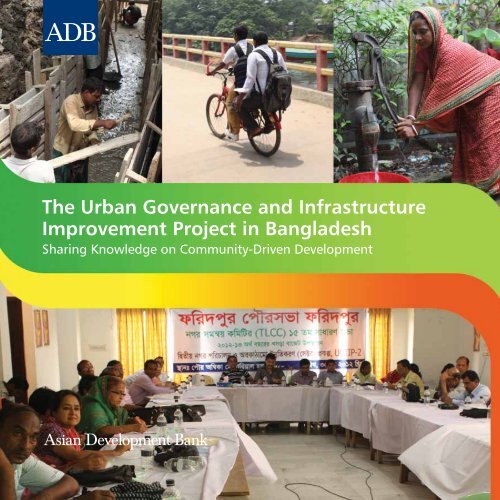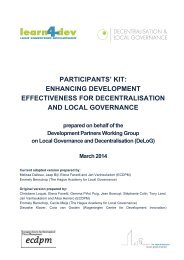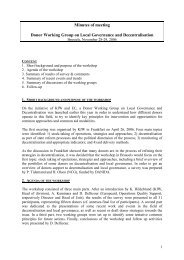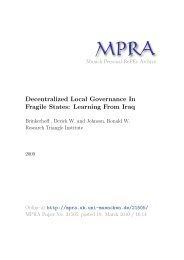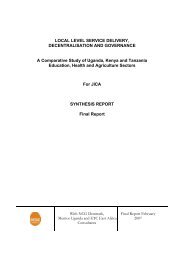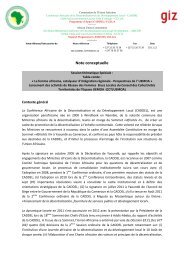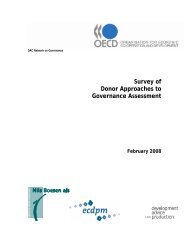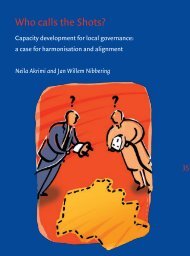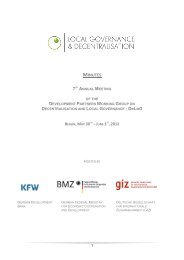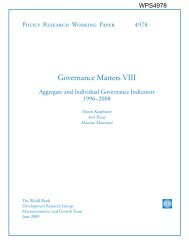The Urban Governance and Infrastructure Improvement ... - DeLoG
The Urban Governance and Infrastructure Improvement ... - DeLoG
The Urban Governance and Infrastructure Improvement ... - DeLoG
Create successful ePaper yourself
Turn your PDF publications into a flip-book with our unique Google optimized e-Paper software.
Contentsiiiiv1125779121919202525272931AbbreviationsAcknowledgmentsIntroductionGeneral IntroductionOverview of the <strong>Urban</strong> <strong>Governance</strong> <strong>and</strong> <strong>Infrastructure</strong> <strong>Improvement</strong> Project (UGIIP)Context of the UGIIPUGIIP’s Performance-Based Fund Allocation StrategyConditions in the Pourashavas before the UGIIP<strong>The</strong> Performance-Based Fund Allocation Strategy<strong>The</strong> Improving Conditions in UGIIP-Supported PourashavasCitizen Participation in the UGIIPEmerging Concepts of People’s ParticipationCitizen Participation in the UGIIPPolicy Reform <strong>and</strong> the UGIIP<strong>The</strong> Policy Context of Pourashava <strong>Governance</strong> before the UGIIP<strong>The</strong> Broader Influence of the UGIIPLessons LearnedClosing Remarksii
IntroductionGeneral IntroductionThis booklet describes how an urban developmentproject—the <strong>Urban</strong> <strong>Governance</strong> <strong>and</strong> <strong>Infrastructure</strong><strong>Improvement</strong> Project (UGIIP)—supported <strong>and</strong> financedby the Asian Development Bank (ADB) is transforminga select group of pourashavas (secondary towns)in Bangladesh. <strong>The</strong> project seeks to improve urbangovernance <strong>and</strong> infrastructure by increasing theparticipation of the community <strong>and</strong> enhancing thecapacity of the pourashava local governments to deliverdesired municipal services to the people.<strong>The</strong> first project, UGIIP-1, was implemented from 2003 to2010. UGIIP-2 was launched in 2009 <strong>and</strong> is scheduled tobe completed in 2014.Both UGIIPs are being implemented by the LocalGovernment Engineering Department (LGED) of theMinistry of Local Government, Rural Development<strong>and</strong> Cooperatives, the national agency responsiblefor extending technical support to all rural <strong>and</strong> urbanlocal governments, including those in pourashavas. <strong>The</strong>LGED, a unit within the ministry’s Local GovernmentDivision, is the ministry’s main executing departmentfor urban infrastructure development projects withinthe municipalities <strong>and</strong>, to a limited extent, the citycorporations (including roads, drains, solid waste,markets, etc.). <strong>The</strong> LGED has implemented a largenumber of donor-assisted <strong>and</strong> Bangladesh government–funded infrastructure development projects over thelast 3 decades <strong>and</strong> has considerable experience, systems,<strong>and</strong> procedures to implement projects efficiently.It is currently the single-largest national agencychanneling infrastructure funding <strong>and</strong> technicalassistance to pourashavas.Both UGIIP-1 <strong>and</strong> UGIIP-2 have features that makethem different from previously implemented urb<strong>and</strong>evelopment projects in Bangladesh. <strong>The</strong>se projects(i) promote good governance; (ii) build capacity toimprove the performance of pourashavas in mobilizingtheir own resources <strong>and</strong> delivering better services to thepeople, especially the poor; <strong>and</strong> (iii) assist municipalitiesin mobilizing the community through grassrootsorganizations for the planning, implementation, <strong>and</strong>monitoring of programs that affect their lives. <strong>The</strong>sespecial features have one common characteristic: theyput the community at the heart of development.<strong>The</strong> chosen pourashavas know that they will receivedevelopment funds under the project, but only afterthey have fulfilled a number of designated tasks relatingto improved urban governance <strong>and</strong> their own capacity.In the UGIIP, money is not meant to be charity; rather,1
UGIIP-2, which is being implemented over a 6-yearperiod that started in 2009, will be completed in 2014at an estimated cost of $167.5 million, double theinvestment in UGIIP-1. As UGIIP-2’s lead donor, ADB iscontributing $87 million (51.9% of the total cost), whiletwo German donors—KFW <strong>and</strong> GIZ—are providing $36.1million (21.6%) <strong>and</strong> $4.7 million (2.8%), respectively. <strong>The</strong>Government of Bangladesh has invested $31.7 million(18.9%) in UGIIP, <strong>and</strong> the pourashava local governmentsare contributing $7.3 million (4.4%) <strong>and</strong> communitybeneficiaries $0.7 million (0.4%). Thirty-five pourashavasin seven divisions of the country were included inphase 1 <strong>and</strong> successfully qualified for phase 2 of UGIIP-2.Both projects are recognized as models of urb<strong>and</strong>evelopment that ensure sustainability, goodgovernance, accountability, <strong>and</strong> transparency throughcommunity participation in the planning, monitoring,<strong>and</strong> implementation of projects identified <strong>and</strong> designedby the community people themselves.According to Md. Wahidur Rahman, LGEDchief engineer:LGED had earlier received a series ofADB urban sector assistance projectssince the early 1990s. However, itwas only after policy shifted frommere investment to a performancebasedapproach that remarkablechange came about in the urb<strong>and</strong>evelopment efforts of the Bangladeshgovernment. <strong>The</strong> approach, which linksgovernance improvement <strong>and</strong> capacitydevelopment with infrastructureinvestment, started in UGIIP-I <strong>and</strong> hasreached new heights through theongoing UGIIP-2. <strong>The</strong> performancebasedmechanism of UGIIP-1 <strong>and</strong> -2is now well appreciated among othermunicipalities, which clearly underst<strong>and</strong>how this project strategy can help themtoward sustainability. We have receivedmore than 100 applications from othermunicipalities, which have expressedinterest in being included in the thirdphase of UGIIP-2. <strong>The</strong> governmentwould like to continue this approach inthe future together with ADB <strong>and</strong> otherdevelopment partners.<strong>The</strong> goal of UGIIP-2 is to promote human development<strong>and</strong> good urban governance in secondary (medium <strong>and</strong>smaller) towns <strong>and</strong> support them in leading sound <strong>and</strong>balanced urban development.UGIIP-2 has two objectives in support of this goal:(i) to develop <strong>and</strong> improve urban infrastructure facilitiesto increase economic opportunities <strong>and</strong> to reducevulnerability to environmental degradation, poverty,<strong>and</strong> natural hazards; <strong>and</strong> (ii) to enhance accountability inmunicipal management <strong>and</strong> strengthen the capacities ofurban municipalities to deliver services.<strong>The</strong> two objectives are to be achieved through the threekey components of UGIIP-2:3<strong>The</strong> <strong>The</strong> <strong>Urban</strong> <strong>Urban</strong> <strong>Governance</strong> <strong>and</strong> <strong>and</strong> <strong>Infrastructure</strong> <strong>Improvement</strong> Project Project in Bangladesh: in Sharing Sharing Knowledge on Community-Driven on Development
Income poverty in urban areas declined to 21.3% in 2010 but non-income povertycontinues to be a challenge in these areas.ADB photo libraryBangladesh reported a significant <strong>and</strong> impressivereduction in income poverty, from 59% in FY1992to 31.5% in 2010, one of the fastest rates of declinerecorded worldwide. <strong>Urban</strong> poverty likewise declined,from 45% to 21.3% in 2010. 4 With the massive reductionin poverty incidence, the absolute number of urbanpoor declined from 10 million in 2005 to 9 million in2010. Despite this, non-income poverty continues tobe a challenge in the urban areas, particularly the slumswhich are in desperate need of basic services<strong>and</strong> infrastructure.Higher income inequality in urban areas <strong>and</strong> a numberof local <strong>and</strong> socioeconomic factors spell considerablemisery for specific groups. For example, a 2005 ADBstudy reported that the poverty incidence amongwomen-headed households in urban areas is higherby 14 percentage points than the urban average, <strong>and</strong>for those residing in slum locations, it is higher by34 percentage points. Of course, the inadequacy ofurban services—slum housing, sanitation facilities,<strong>and</strong> public health <strong>and</strong> education services— broughtabout by the rapidly growing urban populationworsens the vicious cycle of social <strong>and</strong> economicdisempowerment arising out of higher incomeinequities in the urban areas.4Bangladesh Bureau of Statistics. 2011. Report of the Household Income <strong>and</strong> Expenditure Survey 2010. Dhaka.6<strong>The</strong> <strong>Urban</strong> <strong>Governance</strong> <strong>and</strong> <strong>Infrastructure</strong> <strong>Improvement</strong> Project in Bangladesh: Sharing Knowledge on Community-Driven Development
UGIIP’S Performance-BasedFund Allocation StrategyConditions in the Pourashavas beforethe UGIIP<strong>Urban</strong>ization in Bangladesh has produced unplanned<strong>and</strong> uncontrolled urban growth, resulting in an acuteshortage of infrastructure, poor housing <strong>and</strong> transport,inadequate drinking water, <strong>and</strong> lack of drainage<strong>and</strong> sewage.<strong>Urban</strong> residents, particularly low-income groups, suffera lack of basic urban infrastructure <strong>and</strong> services. While95% of the Bangladesh population reportedly has accessto water, only 30% of urban households drink tap water<strong>and</strong> fewer than 20% have their own house connections.<strong>The</strong> pourashavas <strong>and</strong> the elected councils are strugglingto provide the key services they are m<strong>and</strong>ated to deliver:• provision <strong>and</strong> supply of pure water;• construction <strong>and</strong> maintenance of roads;• management <strong>and</strong> collection of garbage;• installation <strong>and</strong> maintenance of street lights;• registration of births <strong>and</strong> deaths;• provision of citizenship <strong>and</strong> family certificates;• building <strong>and</strong> provision of graveyards <strong>and</strong>cremation places;• provision of street water pipes;• planting of trees;ADB photo libraryA woman fetches water from a truck.7<strong>The</strong> <strong>Urban</strong> <strong>Governance</strong> <strong>and</strong> <strong>Infrastructure</strong> <strong>Improvement</strong> Project in Bangladesh: Sharing Knowledge on Community-Driven Development
• eradication of mosquitoes;• running of primary health centers <strong>and</strong>elementary schools;• construction <strong>and</strong> maintenance of public markets<strong>and</strong> toilets;• provision of trade licenses;• maintenance of slums, bus stations, <strong>and</strong>sanitary latrines;• provision of vaccination programs;• collection of property taxes;• monitoring of the construction of buildings, shops,<strong>and</strong> public parks; <strong>and</strong>• management of traffic <strong>and</strong> vehicle registration.However, the performance of the pourashavas has beenfar from satisfactory. <strong>The</strong>se local government institutionssuffer chronic shortages of their own resources, leavingthem dependent on national government allocations.Not only do they lack money <strong>and</strong> resources, they alsolack capacity. Tax collection has been poor because notenough officials have been designated to collect taxes<strong>and</strong> the staff assigned lack the necessary skills, thusallowing many residents to stay outside the tax net.Even those willing to pay taxes on time have becomedefaulters simply because no government employeeshave approached them for payment.<strong>The</strong> lack of a computerized database of taxpayers hasreportedly allowed a few less-than-honest employeesto take their time before depositing the collected taxesin municipal funds <strong>and</strong> having them entered into cashregisters. This practice allows the employees to hold themoney for days <strong>and</strong> invest it in their personal businesses.Pourashava delivery of urban services also presentsa dismal picture. Traffic congestion is common in thepourashavas because of lack of roads <strong>and</strong> poor trafficmanagement. <strong>The</strong>re is no systematic garbage collectionplan for homes. Thus, garbage collection is slow <strong>and</strong>, inthe absence of garbage bins in many places, stinkinggarbage is dumped on the streets, where it often liesuncollected for days. Pavements <strong>and</strong> streets are oftenlittered with waste left by pavement vendors.Many streets are dark at night, for lack of lights, makingthe streets <strong>and</strong> alleys havens for muggers. Ironically,many of these streets are sometimes lighted during theday when artificial lighting is clearly unnecessary. Suchwaste often goes unnoticed by pourashava employees,as well as by community residents.Pourashavas are also known for poor sanitation.According to the UGIIP, at least 30% of urban residentshave no access to sanitary latrines, <strong>and</strong> 40% of slumdwellers defecate in the open for lack of latrines.<strong>The</strong>re are no sewage lines in most pourashavas<strong>and</strong> many residents do not seem to care aboutwaste management.Poor people who migrate to the towns in search ofjobs <strong>and</strong> better living conditions usually end up inslums where amenities are virtually nonexistent.Dreams of work <strong>and</strong> better living conditions attractpoor people from the impoverished rural villages to big<strong>and</strong> small towns. Once there, however, they find thattheir living conditions have hardly improved. For manyof them, it is like jumping from the frying pan rightinto the fire.8<strong>The</strong> <strong>Urban</strong> <strong>Governance</strong> <strong>and</strong> <strong>Infrastructure</strong> <strong>Improvement</strong> Project in Bangladesh: Sharing Knowledge on Community-Driven Development
More than the lack of funds, UGIIP has identified the poorstate of governance <strong>and</strong> lack of community participationas the two major reasons for the poor performance ofthe pourashavas.For decades, the elected representatives <strong>and</strong> localofficials have decided what is good for the community.Community members have rarely been asked whatthey want <strong>and</strong> what the development priorities in theircommunities should be. Communities have been leftout of the planning <strong>and</strong> implementation of projects <strong>and</strong>programs undertaken by the pourashavas.It is normal for the citizens’ relationship with thepourashava councils to end on the day of voting. <strong>The</strong>elected leaders are generally not available to hear aboutthe problems of the voters until the next polls. <strong>The</strong>re isno institutional arrangement for involving communityresidents in making decisions that affect their lives <strong>and</strong>the lives of their children. Nor is there any mechanism formaking the elected representatives accountable to thecommunity. Consequently, there is no transparency inthe work of the pourashavas.governance, capacity, <strong>and</strong> performance in deliveringthe services. Policy makers, elected representatives, <strong>and</strong>foreign donors have therefore been forced to review<strong>and</strong> redesign the whole strategy of urban development,especially the development of pourashavas, on the basisof the lessons learned from previously implementedurban sector development projects.From past failures, policy makers have learned that,quite simply, the top–down approach does not work, asit alienates the community from the service providers.What is needed is a bottom–up approach. This allowscommunity residents to mobilize themselves inorganized bodies to discuss their needs <strong>and</strong> problems<strong>and</strong> make decisions about what is good for them. This isthe basic principle that is being applied in the successfulimplementation of the UGIIP.Thus, governance <strong>and</strong> the participation of communitiesin the affairs of their pourashavas have emerged as thekey elements in enabling the pourashavas to deliverbetter services to the residents.<strong>The</strong> Performance-Based FundAllocation StrategyDespite a good amount of government funds <strong>and</strong>foreign aid over the past decades, the performanceof the pourashavas has hardly improved in terms ofLGEDCBO members in an awareness-raising meeting at Jhalokathi pourashava9<strong>The</strong> <strong>Urban</strong> <strong>Governance</strong> <strong>and</strong> <strong>Infrastructure</strong> <strong>Improvement</strong> Project in Bangladesh: Sharing Knowledge on Community-Driven Development
A key component of UGIIP-1 <strong>and</strong> UGIIP-2 is the UGIAP,which is the core of the performance-based fundallocation strategy. <strong>The</strong> UGIAP is being implementedin three phases <strong>and</strong> there are performance criteria setfor each phase. A participating pourashava must fulfillthe phase 1 performance criteria in order to move intophase 2, <strong>and</strong> so on.<strong>The</strong> performance criteria for phase 1 of UGIIP-2(first 1.5 years) include the following:• formation of a town-level coordinationcommittee (TLCC);• formation of a ward-level coordinationcommittee (WLCC);• formation of a community-based organization;• formation of a gender committee with a womancouncilor as the chairperson;• establishment of an urban planning unit ofthe pourashava;• preparation of a pourashava development planincluding a gender action plan <strong>and</strong> a poverty actionplan; <strong>and</strong>• continuation of the program to fix the holding tax foran interim period.Tasks have been set for each of the seven activities.For example, each pourashava must form a 50-memberTLCC in phase 1. Another m<strong>and</strong>atory condition is thata TLCC must meet at least three times during thisperiod <strong>and</strong> prepare minutes of the meetings.<strong>The</strong> project pourashavas received 50% of theirinfrastructure allocation only after having successfullyachieved the above performance criteria.Participating pourashavas need to achieve all sevengovernance improvement milestones of phase 1 ofUGIIP-2 to graduate to phase 2. Pourashavas that do notachieve these milestones will not graduate to phase 2 orreceive infrastructure fund allocations until they do so,although they will not be dropped from theproject. UGIIP provides capacity building <strong>and</strong>guidance to pourashavas to help them meet theseperformance requirements.On graduating to phase 2, pourashavas are entitled to amaximum of 50% of their total infrastructure investmentallocation under the project for use in phase 2.In phase 2, participating pourashavas are requiredto achieve the following governance improvementmilestones:• Citizen participation <strong>and</strong> accountabilityimprovements, including (i) preparing <strong>and</strong> issuing acitizens’ charter; (ii) initiating the conduct of “citizens’report card” surveys <strong>and</strong> publishing the results;(iii) establishing a customer <strong>and</strong> grievance redresscell; (iv) organizing regular town- <strong>and</strong> wardlevelcoordination committee meetings for theimplementation of the pourashava development planprocess <strong>and</strong> other input <strong>and</strong> decisions; (v) opening upthe budget proposal to the public <strong>and</strong> the TLCC; <strong>and</strong>(vi) establishing a mass communication cell.• <strong>Improvement</strong> of urban planning processes,including (i) hiring a full-time town planner for allclass A pourashavas, (ii) preparing or updating abase map <strong>and</strong> l<strong>and</strong> use map; <strong>and</strong> (iii) preparingannual operations <strong>and</strong> maintenance work plans forsubprojects supported under UGIIP-2.10<strong>The</strong> <strong>Urban</strong> <strong>Governance</strong> <strong>and</strong> <strong>Infrastructure</strong> <strong>Improvement</strong> Project in Bangladesh: Sharing Knowledge on Community-Driven Development
Abir Abdullah• Promotion of gender equity <strong>and</strong> gendermainstreaming, including (i) finalizing a genderaction plan, <strong>and</strong> (ii) allocating <strong>and</strong> spending a specificpercentage of the pourashava budget on genderactivities as outlined in the plan.• Integration of the urban poor, including(i) implementing the poverty reduction action plan,(ii) forming slum improvement committees in slumstargeted by the project, <strong>and</strong> (iii) allocating a budget forthe poverty reduction plan activities.• Financial accountability <strong>and</strong> sustainability,including (i) computerizing accounting system;(ii) computerizing tax records <strong>and</strong> generating bills bycomputer; (iii) preparing financial statements, <strong>and</strong>Farida Parvin, a municipal computer specialist, processestrading licences.having them audited by the audit st<strong>and</strong>ing committeeof the pourashava (internal audit) within 3 monthsof the closing of the financial year; (iv) undertakingan annual interim assessment of property taxes <strong>and</strong>increasing collections by at least 10% each year;(v) achieving annual increases in nontax revenueincome that are at least equal to the inflation rate;(vi) repaying in full all debts owed to government<strong>and</strong> other entities, according to schedule; <strong>and</strong>(vii) paying in full all outst<strong>and</strong>ing bills, includingelectricity <strong>and</strong> telephone bills.• Administrative transparency, including (i) developingan adequate staff structure (according to size <strong>and</strong>needs) with detailed job descriptions to enablethe pourashava to undertake its current <strong>and</strong>future obligations effectively, (ii) training electedrepresentatives <strong>and</strong> executive personnel,(iii) submitting timely progress reports on UGIAPimplementation <strong>and</strong> other activities to the projectmanagement office, (iv) establishing <strong>and</strong> activatingst<strong>and</strong>ing committees at pourashavas, (v) performingquality assurance of infrastructure works <strong>and</strong> involvingregional LGED offices, <strong>and</strong> (vi) initiating e-governanceactivities.Pourashavas that do not achieve even the minimumperformance ratings at the end of phase 2 will not bepermitted to graduate to phase 3. <strong>The</strong>y will receive nofurther funding <strong>and</strong> will be dropped from the project.Achieving the minimum performance ratings in phase 2will allow a pourashava to graduate to phase 3 <strong>and</strong>receive another 25% of its investment allocation.11<strong>The</strong> <strong>Urban</strong> <strong>Governance</strong> <strong>and</strong> <strong>Infrastructure</strong> <strong>Improvement</strong> Project in Bangladesh: Sharing Knowledge on Community-Driven Development
Fully satisfactory performance in phase 2 will entitlea pourashava to the remaining 50% of its fundingallocation from the project. In addition, it will be eligiblefor additional funds for infrastructure investments fromthe unused allocations of pourashavas that have notachieved the minimum or achieved only the minimumperformance in their phase 2 milestones. <strong>The</strong> dispositionof these unused funds will be decided by the projectmanagement office <strong>and</strong> ADB after phase 2 evaluations.UGIIP-2 puts emphasis on enhancing the pourashavas’performance in tax collection. <strong>The</strong> project requires eachpourashava to carry out an annual reassessment of theholding tax <strong>and</strong> to increase collection by more than5% annually (up to 80% collection efficiency) to stayin the project <strong>and</strong> move to phase 3. Nonperformerswill be dropped from the project. This rigorousrequirement has stirred the pourashavas to action <strong>and</strong>set off a competition to do even better, resulting in theincreased collection of property taxes <strong>and</strong> license fees ofbusinesses operating in the municipal areas.ADB’s senior project officer, Md. Rafiqul Islam, assessesthe performance-based allocation strategy as follows:<strong>The</strong> resource allocation is conditional oncompliance with a set of performancetargets relating to citizen participation,improved capacity, <strong>and</strong> better servicedelivery. <strong>The</strong> municipalities are nowpracticing discipline. Municipaldevelopment plans have been prepared,<strong>and</strong> tax collection has substantiallyincreased, from an average of 30%to around 80%. Staff salaries areregularly paid. Accounting <strong>and</strong> billingare computerized. Annual budgets <strong>and</strong>development subprojects are discussed<strong>and</strong> endorsed by citizens. Citizens are nowhappier than ever before.Abir AbdullahMunicipal office of Tongi, a pourashava covered by UGIIP<strong>The</strong> Improving Conditions inUGIIP-Supported PourashavasAt present, Bangladesh has 316 pourashavas, statutorybodies that are meant to serve their residents withbetter streets, sanitary latrines, pure drinking water,street lights, <strong>and</strong> efficient management of garbage <strong>and</strong>poverty reduction programs for the poor.12<strong>The</strong> <strong>Urban</strong> <strong>Governance</strong> <strong>and</strong> <strong>Infrastructure</strong> <strong>Improvement</strong> Project in Bangladesh: Sharing Knowledge on Community-Driven Development
With the support of the UGIIP <strong>and</strong> its developmentpartners, 65 pourashavas (30 in UGIIP-1 <strong>and</strong> 35 inUGIIP-2) are blazing a new path, gradually transformingthemselves into competent entities that are responsiveto the needs of the community, accountable for theiractions, <strong>and</strong> transparent in their activities.<strong>The</strong> pourashavas supported by the UGIIP are showingthe way for other municipalities outside the project.<strong>The</strong>ir efficiency in tax collection has improved a greatdeal, as their staff have been trained to use computersin issuing trade licenses <strong>and</strong> water bills. <strong>The</strong> streets inthese pourashavas are cleaner, with trucks procuredwith project funds collecting garbage from homes.Community residents in these project pourashavasare more aware of their responsibilities <strong>and</strong> eager tovisit their pourashava local governments to expresstheir opinions.respondent households claim that they now have moreassets. Household incomes have likewise increased <strong>and</strong>the increase is attributed mainly to the improvementsin urban infrastructure facilities brought about by theUGIIP interventions. <strong>The</strong> evaluation found that 56%of respondent households considered their incomesufficient to meet household expenses, an increase of sixpercentage points over the 50% of households that toldthe baseline survey staff that their income was sufficientfor household needs.What have these improvements meant toordinary citizens?Following are the perceptions of pourashava residentsthemselves as gathered through (i) a comprehensiveevaluation of UGIIP-1 participating pourashavas todetermine the effects <strong>and</strong> impact of the project onurban governance <strong>and</strong> infrastructure improvement, <strong>and</strong>(ii) field interviews done to gather data for this booklet.<strong>The</strong> evaluation study also involved consultations with asample of residents from the participating pourashavas<strong>and</strong> comparisons of their current perceptions withbaseline studies done before the start of UGIIP-1 in 2003.Income improvements. Compared with the assetsthey possessed during the baseline survey period,Abir AbdullahMala Rani Das, 45, makes brooms with the Tk20,000 she borrowed from Bhairab municipalityunder the slum development component of UGIIP.13<strong>The</strong> <strong>Urban</strong> <strong>Governance</strong> <strong>and</strong> <strong>Infrastructure</strong> <strong>Improvement</strong> Project in Bangladesh: Sharing Knowledge on Community-Driven Development
Box 1: Case Studies on MicrofinanceIn one of the slums, Mala Rani Das, 45, was shaping a cleaning st<strong>and</strong> with long, thin sticks gathered from coconut tree leaves. With help from herhusb<strong>and</strong>, she makes enough st<strong>and</strong>s to earn her Tk200 ($2.40) a day. That takes her monthly income to Tk6,000 ($73), more than the monthly wageof an average industrial worker in Bangladesh. Rani is a member of a 15-member, women-only credit group whose objective is to help its membersget small loans provided by Bhairab pourashava’s poverty reduction program. <strong>The</strong> amount of loans for a person ranges from Tk5,000 ($60) toTk50,000 ($602) depending on the borrower’s repayment record.<strong>The</strong>re are 1,800 poor families covered by the poverty reduction program in Bhairab, says Syed Ahaduzzaman, the slum development officer. Rani’sfamily is among them <strong>and</strong> she has recently taken out a new loan of Tk10,000 ($120) to exp<strong>and</strong> her business.In another part of town, on the banks of the Meghna River, Safia Akther, 45, is rearing a cow she bought 4 months ago at a cost of Tk10,000 ($120),<strong>and</strong> in the next 3 months she hopes to sell it for at least Tk50,000 ($602). Any other expenditure, over <strong>and</strong> above the money from the loan? “My laboronly. I collect grass for the cow from the riverside near my house.” Akther borrowed the money under the pourashava’s small loan program, whichhelps poor people start small businesses so they can pull themselves out of poverty.“This is amazing. This is happening in a country where a large number of people live on only $2 a day,” says Md. Shahin, the mayor of Bhairab. One ofthe m<strong>and</strong>atory provisions for getting the loan is that each borrower must deposit Tk30 (36 cents) a month in a savings account at a state-run bank,to be returned on dem<strong>and</strong> to meet any emergency of the borrower. <strong>The</strong> loan carries an interest rate 15% lower than what the commercial bankscharge, <strong>and</strong> no installment is to be paid in the first month.Improved living conditions. As many as 95% ofrespondent households said that they draw water froma nearby water supply source or pipeline that has beenconstructed by the pourashava. Eighty-five percent ofrespondents stated that the water quality is good <strong>and</strong> insufficient quantity.Abir AbdullahSafia Akther, 45, with the cow she bought with the money borrowed from Bhairabmunicipality under the UGIIP14According to 75% of survey respondents, road surfacesare good. Drains are likewise well maintained bypourashava workers.More than 90% of sample respondents claimed touse sanitary latrines, a remarkable improvement overreported usage during the baseline survey period.<strong>The</strong> <strong>Urban</strong> <strong>Governance</strong> <strong>and</strong> <strong>Infrastructure</strong> <strong>Improvement</strong> Project in Bangladesh: Sharing Knowledge on Community-Driven Development
<strong>The</strong>se sanitation improvements are also partly due tothe government’s goal of 100% sanitation coverage by2013. At the same time, 90% of respondents consideredthe condition of their latrines either good or satisfactory.<strong>The</strong>se improvements have likewise been attributed tothe UGIIP interventions.Most respondents reported that they dispose of theirhousehold wastes in dustbins placed by the pourashavasin selected places. This is in contrast to the findings ofthe baseline survey that only 10% of survey householdsused garbage bins. Evaluation respondents mentionedtwo important benefits from the use of the dustbins forsolid waste disposal. <strong>The</strong> first benefit is getting rid of thebad smell from rotting garbage. <strong>The</strong> second is gettingrid of the flies <strong>and</strong> mosquitoes that used to accompanythe open garbage. Significantly, 70% of respondents areprepared to pay for solid waste collection services in thefuture, if required.Abir AbdullahA slum dweller collects water from a tube well built by Narayanganj municipality underthe UGIIP.Box 2: Better Quality of LifeIn Narayanganj, an industrial river port city, UGIIP has transformed overcrowded slums into clean residential blocks of brick houses. Dirt,mud, <strong>and</strong> garbage that used to pile up along the overflowing drains are long gone. Even though the streets in the slums are still narrow <strong>and</strong>overcrowded, these are now made of concrete <strong>and</strong> the drains are covered with slabs so smooth that children can play games like cricket onthem. <strong>The</strong> Rishipara slums st<strong>and</strong> beside a canal <strong>and</strong> are connected with the main streets by several small bridges. <strong>The</strong>re are latrines <strong>and</strong> streetlights, once considered luxuries for poor people.Farther northeast from Narayanganj is Bhairab, another river port town with a population of 130,000, nearly one-third of them living in 24slums. Most of the slum dwellers depend on odd jobs such as repairing shoes, cleaning the streets, or running small convenience shops.Before the UGIIP came, the slums were clusters of mud-<strong>and</strong>-straw huts with no sanitary latrines, no supply of pure drinking water, <strong>and</strong> noschools for the children. With no regular jobs, women in the slums would pass the time lazing around <strong>and</strong> sometimes pick quarrels withneighbors over trivial matters. Many lived by borrowing money at high interest rates from big money lenders, plunging themselves furtherinto debt <strong>and</strong> misery.Today, the slum dwellers have concrete homes to live in, with pure drinking water available from wells dug with funds made availabe byUGIIP, lights for the narrow but clean alleys, small loans for women, <strong>and</strong> schools for children—services unavailable in the country’s manyother small towns.15<strong>The</strong> <strong>Urban</strong> <strong>Governance</strong> <strong>and</strong> <strong>Infrastructure</strong> <strong>Improvement</strong> Project in Bangladesh: Sharing Knowledge on Community-Driven Development
People queue up to pay their taxes at the municipal office of Tongi.Schoolchildren attend a class in a pre-primary school run by the Bhairab municipality underthe UGIIP.16Abir AbdullahAbir AbdullahImproved tax collection. In Faridpur, a UGIIP-2 town,the pourashava council has formed several “RedBrigades” comprising officials <strong>and</strong> volunteers to goafter defaulters <strong>and</strong> collect the outst<strong>and</strong>ing taxes. <strong>The</strong>brigades are so named because the members wear redT-shirts during their campaigns.“We serve notices to the defaulters <strong>and</strong> wait for 15 daysto clear their dues,” says Faridpur Mayor Sheikh MahtabAli Methu. “We send the Red Brigades only when thedefaulters fail to respond by the deadline.” Movableassets of the chronic defaulters are often seized as acollection tactic.This measure, Ali says, is working. In FY2011, the rate oftax collection in his pourashava was only 60%. <strong>The</strong> ratehad already increased to 65% by May of FY2012, whichended on 30 June. <strong>The</strong> tax collection rate was expectedto rise further, up to at least 80%, as many people paytaxes on the last day of the fiscal year.Tongi pourashava, a UGIIP-1 town just outside thecapital, Dhaka, is doing even better. <strong>The</strong> rate of collectionof property taxes in this industrial town rose to 98% inFY2011, up from 11.5% in 1995. “Our tax collection hasbecome more efficient. We are not going below 90%,”says Mayor Md. Azmat Ullah Khan. “We know that if wefall behind in meeting the performance criteria, we willbe dropped from the project.”Improved education services. Bhairab pourashavahas even more tales of accomplishment. It runs25 elementary schools for free for about 15,000 slumkids, providing them with books, pencils, <strong>and</strong> othereducation materials.<strong>The</strong> <strong>Urban</strong> <strong>Governance</strong> <strong>and</strong> <strong>Infrastructure</strong> <strong>Improvement</strong> Project in Bangladesh: Sharing Knowledge on Community-Driven Development
In one of these schools in Madhya Rishipara, 36 boys<strong>and</strong> girls take lessons from their teacher, Archana RaniSutradhar, also a slum resident. Under a tin-roof hut, thestudents learn about the alphabet, recite rhymes, <strong>and</strong>learn how to count.On a hot summer day in June, the students greet a groupof visitors with the chorus “Twinkle, twinkle, little star.How I wonder what you are….”Binti, a 6-year-old, demonstrates her dancing skills whileSharif, a slightly older child, sings a song. “I want to bea doctor,” a shy Binti tells the visitors. Sharif says he willbecome a teacher. <strong>The</strong>y are dreaming big, but theirdreams are not impossible.Improved responsiveness to citizens’ needs. EveryUGIIP pourashava has prepared a citizens’ charterdetailing the services it provides to the citizens, thelocation of the facilities, <strong>and</strong> the fees. <strong>The</strong> services mustbe listed on a large board put up in the pourashavacompound <strong>and</strong> open to public view. <strong>The</strong> servicesavailable are also made known to the public throughleaflets <strong>and</strong> small boards in different parts ofthe town.Citizens’ complaints are now better heard <strong>and</strong> attendedto. “I’ve come here to get a mistake in my birth certificatecorrected,” says Abdul Halim, a college student in Tongi, apourashava just outside Dhaka. “That has been done. Myname is already in the computer database. So it was easyfor the staff to fix the mistake,” he says with a smile as heleaves the neat <strong>and</strong> clean pourashava complex.With the improvement in the amount <strong>and</strong> quality ofservices, community members are dem<strong>and</strong>ing even morefrom the pourashavas. “It is my pourashava. I belong to itAbir AbdullahTwo men read the citizens’ charter that details the services offered by the municipality of Tongito its constituents.17<strong>The</strong> <strong>Urban</strong> <strong>Governance</strong> <strong>and</strong> <strong>Infrastructure</strong> <strong>Improvement</strong> Project in Bangladesh: Sharing Knowledge on Community-Driven Development
<strong>and</strong> so it is my responsibility to take care of it,” says TaraBegum, a slum resident, at a TLCC meeting in Faridpur.<strong>The</strong> grievance redress cell set up in each pourashavaenables citizens to submit their complaints in writing.This cell also serves as an arbitration mechanism aselected representatives <strong>and</strong> pourashava officials mustfind early solutions for these complaints. Citizens feelencouraged to seek redress for disputes over l<strong>and</strong>,business, or even family conflicts from the pourashavasbefore going to court. “Around 60% of such disputes arenow settled at the pourashava level,” claims ChowdhuryFazle Bari, team leader of the UGIIP-2 governanceimprovement <strong>and</strong> capacity development consultingteam, speaking on the basis of information his team hasgathered from the participating pourashavas.<strong>The</strong> ADB country director for Bangladesh, M. TeresaKho, considers the UGIIP one of the best examples of aperformance-based investment project. Accordingto her,<strong>The</strong> project has inspired resourceconstrainedmunicipalities to improveservice delivery through a substantialincrease in local revenues <strong>and</strong> theparticipation of citizens. ADB feelsencouraged as the government <strong>and</strong> otherdevelopment partners (KfW, GIZ, <strong>and</strong> JICA)have cooperated to replicatethis approach.Abir AbdullahWomen <strong>and</strong> men attend a town-level coordination committee meeting in Faridpur.18<strong>The</strong> <strong>Urban</strong> <strong>Governance</strong> <strong>and</strong> <strong>Infrastructure</strong> <strong>Improvement</strong> Project in Bangladesh: Sharing Knowledge on Community-Driven Development
Citizen Participation in the UGIIPEmerging Concepts of People’s ParticipationCommunity-driven development is a subset of the muchbroader community-based development approach,encompassing a wide range of projects that activelyinclude beneficiaries in their design, management,<strong>and</strong> implementation. ADB defines community-drivendevelopment (CDD) projects as having five key elements:• <strong>The</strong>y are community focused: the target beneficiary,grantee, or implementing agent is some form ofcommunity-based organization or representativelocal government.• <strong>The</strong>y involve participatory planning <strong>and</strong> design.• <strong>The</strong> community has direct control over key projectdecisions, as well as the management of investmentfunds <strong>and</strong> other resources.• <strong>The</strong> community is involved in implementation throughdirect supply of input, labor, or funds, or indirectlythrough management <strong>and</strong> supervision of contractorsor operation <strong>and</strong> maintenance functions.• CDD projects employ community-based participatorymonitoring <strong>and</strong> evaluation to ensure downwardaccountability to the community.Abir AbdullahCommunity members take an active part in the construction of a small road over a drain in aslum in Bhairab.19<strong>The</strong> <strong>Urban</strong> <strong>Governance</strong> <strong>and</strong> <strong>Infrastructure</strong> <strong>Improvement</strong> Project in Bangladesh: Sharing Knowledge on Community-Driven Development
CDD has much in common with social accountability,which is an approach to building accountability throughcivic engagement—that is, actions taken by ordinarycitizens <strong>and</strong> their organizations to exact accountabilityfrom government. <strong>The</strong> objective of social accountabilityis to monitor government conduct <strong>and</strong> performance,<strong>and</strong> hold public officials accountable, as the latter usepublic resources to deliver services, improve people’swelfare, <strong>and</strong> protect people’s rights.Both CDD <strong>and</strong> social accountability aspire to theimportant development outcome of enhanceddemocratic governance <strong>and</strong> improved service delivery tocitizens, especially to the poor.Ensuring public accountability is a two-step process.First, the state needs to have a clear underst<strong>and</strong>ing ofwhat its citizens want. For this to happen, citizens mustbe able to draw on the political process to hold thestate (policy makers <strong>and</strong> politicians) to account. Thisrelationship is referred to as voice. <strong>The</strong> state, in turn, actingas the representative of the people, must be able totransmit these dem<strong>and</strong>s to the actual provider of services<strong>and</strong> ensure that the providers perform their functionseffectively. This relationship is known as the compact.Accountability is ensured when the policy makers canaccurately reflect the voice of their constituents to theservice providers <strong>and</strong> manage to create incentivesthat motivate the providers to follow the voice of theirconstituents accurately <strong>and</strong> conscientiously.Today, there is increasing recognition of the inherentlimitations of traditional accountability channels <strong>and</strong>growing acknowledgement that citizen engagementwith the state—that is, citizens acting as “watchdogs”of government actions—plays an important role instrengthening responsiveness <strong>and</strong> accountability inservice delivery.More recently, however, a number of citizens’ actionshave questioned this separation between the state <strong>and</strong>society. <strong>The</strong>ir experience suggests that accountability isbest obtained in “co-governance” spaces that blur theboundary between the state <strong>and</strong> society. Citizen groupsin various parts of the world are experimenting withthe approach of inserting themselves more directly intothe core functions <strong>and</strong> everyday workings of the stateapparatus, monitoring the latter’s previously opaqueoperations, <strong>and</strong> influencing policy from the inside.<strong>The</strong> UGIIP represents yet another experience inco-governance. In this instance, citizens becomeinvolved in development planning <strong>and</strong> in the monitoringof the actual delivery of public services, thus breakingstate monopoly over an area that previously belongedexclusively to the government.Citizen Participation in the UGIIP<strong>The</strong> mayor of Tongi pourashava, Md. Azmat UllahKhan, is a busy man, sitting in his office surrounded byordinary men <strong>and</strong> women for whom the mayoral officeis always open. During the interview, Khan was signing anumber of certificates of birth <strong>and</strong> citizenship, <strong>and</strong> familysuccession testimonials needed for l<strong>and</strong> deeds.“So many things have changed here,” says Khan, showing aposter that is used to remind citizens it is time to pay theirmunicipal taxes. “Where before we were the ones reachingout to the community, now it is the community people20<strong>The</strong> <strong>Urban</strong> <strong>Governance</strong> <strong>and</strong> <strong>Infrastructure</strong> <strong>Improvement</strong> Project in Bangladesh: Sharing Knowledge on Community-Driven Development
who are coming to us. It’s really becoming the place tobe,” he says, nodding toward two middle-aged womenwho have come to ask the mayor to attend their familymeeting <strong>and</strong> settle l<strong>and</strong> disputes among the siblings.Khan, who is also the president of an association of thecountry’s mayors <strong>and</strong> councilors (the Municipal Associationof Bangladesh), says the key to the success of UGIIP-2 lies inthe participation of the community. Three grassroots bodiesorganized into a three-tier structure are actively involved inpreparing, implementing, <strong>and</strong> supervising the pourashavadevelopment plan <strong>and</strong> its processes: the community-basedorganization, the ward-level coordination committee, <strong>and</strong>the town-level coordination committee.Community-based organization. Citizen participationstarts with the community-based organization (CBO),which usually comprises 200 to 300 families in a locality.<strong>The</strong> UGIIP-2 has already formed a total of 1,750 CBOs inthe 35 participating pourashavas, or an average of 50 ineach municipality.Tongi Mayor Md. Azmat Ullah Khan, an advocate of UGIIP programs, shows a posterthat reminds the community to pay property tax.Abir Abdullah<strong>The</strong> head of a family or a representative above 18 years isentitled to become a member of the CBO. <strong>The</strong> memberselect a 12-member executive committee, one-third ofwhich must be made up of women. <strong>The</strong>re must alsobe representatives from the poor as they make up,on average, 30% of the pourashava population. <strong>The</strong>executive committee comprises five office bearers <strong>and</strong>seven members. Responsibilities are distributed amongthe members (there is a member in charge of drain <strong>and</strong>sanitation management, another for household solidwaste disposal, another for cleanliness, etc.). <strong>The</strong> wardcouncilor in each ward advises the executive committeeof the CBOs in that ward.CBO formation meeting at Ch<strong>and</strong>pur pourashavaLGED21<strong>The</strong> <strong>Urban</strong> <strong>Governance</strong> <strong>and</strong> <strong>Infrastructure</strong> <strong>Improvement</strong> Project in Bangladesh: Sharing Knowledge on Community-Driven Development
While it is not m<strong>and</strong>atory, the mayor <strong>and</strong> the local wardcouncilor usually attend CBO meetings to know firsth<strong>and</strong>the problems that are raised <strong>and</strong> the decisions taken.<strong>The</strong> CBO—as the lowest grassroots organization—takesup social issues in its agenda, such as drug addictionamong the youth <strong>and</strong> sexual harassment of schoolgirls, acommon form of harassment. Preventing child marriage,reducing poverty, <strong>and</strong> giving women jobs (e.g., byproviding them with sewing machines) are also includedin the meeting agenda <strong>and</strong> activities of CBOs.Abir AbdullahWomen at a community meeting discuss social issues including theimportance of paying taxes, <strong>and</strong> water <strong>and</strong> electric bills.“In our last meeting, we adopted a resolution to conducta mass awareness campaign to prevent child marriages,”says Sharmin Sultana, a member of the CBO in Ghorasalpourashava, a UGIIP-2 railway town east of Dhaka. “Weheld several courtyard meetings attended mostly bywomen. Women at the meetings agreed that childmarriage is not good for the society.” In Bangladesh, thelegal age for a boy to marry is 21 years while for girls, it is18. However, marriage below the legally permissible ageis common, especially among girls.Ghorasal Mayor Shariful Haq, who was also present atthe CBO meeting, says “the CBOs play a crucial role inmobilizing the community members against social ills.We take the decisions made here seriously.”<strong>The</strong> activities of the CBOs—who meet once everymonth—are well worked out: management of drainage<strong>and</strong> sanitation, management of household solidwaste, management of clinical <strong>and</strong> marketplace waste,maintenance of community infrastructure, cleaning ofstreets, <strong>and</strong> supervision of street lights.LGEDA CBO- owned van collects wastes at Kalapara pourashava.22<strong>The</strong> <strong>Urban</strong> <strong>Governance</strong> <strong>and</strong> <strong>Infrastructure</strong> <strong>Improvement</strong> Project in Bangladesh: Sharing Knowledge on Community-Driven Development
Ward-level coordination committee. <strong>The</strong> ward-levelcoordination committee (WLCC) meets every 3 months.Headed by the local ward councilor, the WLCC is themiddle rung on the community participation ladder. <strong>The</strong>WLCC is a forum where community members can raisetheir local development <strong>and</strong> social issues more intensely.At a WLCC meeting in Faridpur, another UGIIP-2pourashava west of Dhaka, ward members raised theissue of waterlogging, poor garbage collection, <strong>and</strong> lackof pure drinking water. <strong>The</strong> ward councilor briefed themeeting participants on the progress made in solving thewaterlogging problem <strong>and</strong> assured them that steps arebeing taken to address the other problems.Women <strong>and</strong> the poor are strongly represented in theWLCC, which consists of not more than 10 members. Ofthese, four must be women <strong>and</strong> at least three membersmust be from the poor. A typical WLCC has the councilorof the local ward as its president, while the femalecouncilor, who is elected from the seats reserved onlyfor women, is its vice president. <strong>The</strong> members includerepresentatives of civil society, professional groups,<strong>and</strong> the poor community. An assistant engineer orsub-assistant engineer (nominated by the mayor) is themember secretary for the WLCC.Town-level coordination committee. <strong>The</strong> third <strong>and</strong>most important body is the TLCC, which has no morethan 50 members. <strong>The</strong> TLCC is a unique entity because,unlike other local government bodies, its membershipincludes both government officials from the pourashavacouncil <strong>and</strong> representatives of citizens’ groups <strong>and</strong> otherlocal stakeholders. This organization, which is headed bythe mayor, is known as the parliament of the pourashava.All councilors of a pourashava sit in the TLCC, along withrepresentatives from the district administration; LocalGovernment Engineering Department; DepartmentAbir AbdullahMembers of the WLCC attend a meeting to discuss the development concerns of Faridpur.of Public Health Engineering; Roads <strong>and</strong> HighwaysDepartment; Public Works Department; Ministry of SocialWelfare; Department of Cooperatives; <strong>and</strong> Ministry ofPosts <strong>and</strong> Telecommunications.Most significantly, the TLCC draws a diverse membershipfrom the public, ranging from the elite in the town toits slum dwellers. It is m<strong>and</strong>atory that one-third of TLCCmembers are women, while the poor in the communitymust be represented by at least seven members,including two women.<strong>The</strong> business of the TLCC is serious. This is where thepourashava council—comprising the mayor <strong>and</strong> thecouncilors—are held accountable for their performance.However powerful <strong>and</strong> popular the mayor <strong>and</strong> thecouncilors may be, they are answerable to the peoplewho elected them.23<strong>The</strong> <strong>Urban</strong> <strong>Governance</strong> <strong>and</strong> <strong>Infrastructure</strong> <strong>Improvement</strong> Project in Bangladesh: Sharing Knowledge on Community-Driven Development
Abir AbdullahDr. Selina Hayat Ivy, mayor of Narayanganj <strong>and</strong> key person runningthe UGIIPThis is also the forum where the community peopleget a sense of ownership of their own town. <strong>The</strong>y cometo know that the town belongs to them <strong>and</strong> that theyare also responsible for keeping it clean <strong>and</strong> doingeverything possible to prevent waste <strong>and</strong> pilferage.<strong>The</strong>se all have been done to improve governance <strong>and</strong>enhance the performance of the pourashavas.UGIIP has injected new zeal into the pourashavas <strong>and</strong>brought them closer to the community. As Salina HayatIvy, the popular mayor of Narayanganj City Corporation(a pourashava when the UGIIP was launched), puts it:“UGIIP has built a bridge between the pourashava <strong>and</strong>its residents.”Box 3: <strong>The</strong> Town-Level Coordination Committee—Parliament in a Small Town (A Case Study)<strong>The</strong> meeting begins with everyone introducing himself or herself. <strong>The</strong> mayor takes the lead. “I’m Sheikh Mahtab Ali Methu, the mayor of Faridpur,presiding over today’s meeting.” <strong>The</strong>n, the 50-odd men <strong>and</strong> women attending the meeting of the TLCC state their names <strong>and</strong> what they do.<strong>The</strong> TLCC meeting, which was called to discuss the draft budget of the 143-year-old Faridpur pourashava for FY2013, has brought togetherthe town’s elite, along with commonly ignored residents like Tara Begum, a woman from the slums. Also present at the meeting are collegeteachers, women’s rights activists, development workers, town councilors, businessmen, journalists, <strong>and</strong> lawyers.<strong>The</strong> secretary of the pourashava makes a PowerPoint presentation detailing the minutes of the last meeting for approval. After making a fewchanges, the participants unanimously adopt the minutes <strong>and</strong> then proceed to the main agenda of the day: the draft budget.<strong>The</strong> mayor tells the group that the pourashava is building two shopping centers in the town <strong>and</strong> that women will have priority in theallotment of the stores. He expresses appreciation for the committee’s earlier endorsement of his plan to form Red Brigades to collect taxes(mostly property taxes) from defaulters. <strong>The</strong> move has helped increase the tax collection rate, which is now hitting 75%, up from 70% in 2011.“We hope to raise the rate to 90% by the end of June, when most people pay their taxes,” says the mayor.Before the TLCC approves the Tk1,200 million ($14.4 million) budget with some amendments, Asma Akhtar Mukta, a development worker,draws the attention of the mayor to an earlier promise that shopping centers in the city will have separate toilets for women. She wants toknow if any progress has been made in this regard.24“We have built toilets for women in some of the shopping centers,” says an apologetic mayor. “Others are in the pipeline.”“I’m happy that I’ve got my answer,” says Mukta. “This is a good example of accountability.”<strong>The</strong> <strong>Urban</strong> <strong>Governance</strong> <strong>and</strong> <strong>Infrastructure</strong> <strong>Improvement</strong> Project in Bangladesh: Sharing Knowledge on Community-Driven Development
Policy Reform <strong>and</strong> the UGIIP<strong>The</strong> Policy Context of Pourashava<strong>Governance</strong> before the UGIIPTo bring about more balanced urban growth <strong>and</strong> easethe pressure on the resources <strong>and</strong> infrastructure ofthe bigger cities, the development of pourashavas, thesecondary towns that hold about 40% of the urbanpopulation—is of prime importance. Pourashavas havethe potential to improve living conditions, economy,<strong>and</strong> infrastructure—in short, an alternative destinationfor those who would otherwise migrate to largerurban centers.Despite the rapid urbanization in Bangladesh duringthe last few decades, very little attention has been givento increasing the capacity of the urban local bodiesto deal with the emerging problems. As a result, mostpourashavas are severely deficient in basic infrastructure<strong>and</strong> services <strong>and</strong> clearly unable to keep pace withrapid urbanization.Before the Local Government (Pourashava) Act of 2009,the municipalities of Bangladesh were administeredunder the legal framework of the Pourashava Ordinance1977. <strong>The</strong> ordinance had no specific provision forencouraging the participation of community or citizens’groups in the planning <strong>and</strong> decision-making processesAbir AbdullahA new road built by Narayanganj municipality under the UGIIP25<strong>The</strong> <strong>Urban</strong> <strong>Governance</strong> <strong>and</strong> <strong>Infrastructure</strong> <strong>Improvement</strong> Project in Bangladesh: Sharing Knowledge on Community-Driven Development
of municipalities. Instead, the municipality was governedby an elected chair <strong>and</strong> ward commissioners, whoconstituted the pourashava council. However, sincethe ward commissioners were not directly given anypowers under the ordinance, the chair was the supremedecision-making authority.Earlier assessments before UGIIP-1 had establishedthe following key issues <strong>and</strong> challenges ofpourashava governance:• Pourashava-level weaknesses related to(i) concentration of powers in the chairperson,(ii) weak staffing <strong>and</strong> capacities (with vacancies in staffpositions as high as 30%), (iii) poor revenue recovery,(iv) overdependence on meager national governmentgrants, <strong>and</strong> (iv) persistent neglect of operations <strong>and</strong>maintenance.• Inadequate finances, because of (i) inadequateinvestments at the pourashava level that are notcommensurate with dem<strong>and</strong> for infrastructure, (ii) lackof proper long-term <strong>and</strong> municipal-wide investmentplanning, <strong>and</strong> (iii) overwhelming dependence onnational transfers that are inadequate <strong>and</strong> notresponsive to local needs.• Lack of policy <strong>and</strong> physical planning. <strong>Urban</strong>development policy <strong>and</strong> programming have not beenclearly laid out, leaving pourashavas without direction.Earlier efforts to prepare l<strong>and</strong> use <strong>and</strong> services masterplans have been discontinued, resulting in unplanned,uncontrolled, <strong>and</strong> unregulated development.• Lack of national support for pourashavastrengthening. <strong>The</strong> control exercised by thenational government over pourashavas in terms offinances, staffing, <strong>and</strong> powers relegates the latter tothe subsidiary role of de-concentrated bodies workingas agencies of the national government rather than aselected local governments.In response to the above issues, ADB providedtechnical assistance support in UGIIP-1 for a group ofsix national consultants to support the high-poweredCommittee on <strong>Urban</strong> Local Governments, which wasformed in February 2004 with the minister for localgovernment, rural development <strong>and</strong> cooperatives asits chair. Members of the committee included politicalleaders of pourashavas <strong>and</strong> city corporations, seniorgovernment officials, <strong>and</strong> representatives of professionalorganizations. <strong>The</strong> activities of the committee included,among others, the preparation of the National <strong>Urban</strong>Sector Policy, the review <strong>and</strong> revision of the 1977Pourashava Ordinance, <strong>and</strong> the examination of othercritical issues related to sustainable urban development.<strong>The</strong> consultants helped the ministry draft a revisedPourashava Ordinance, which eventually became thePourashava Act of 2009, <strong>and</strong> the draft National <strong>Urban</strong>Sector Policy. UGIIP-2 is monitoring the finalization of theNational <strong>Urban</strong> Sector Policy, which is expected to beapproved within a few months.26<strong>The</strong> <strong>Urban</strong> <strong>Governance</strong> <strong>and</strong> <strong>Infrastructure</strong> <strong>Improvement</strong> Project in Bangladesh: Sharing Knowledge on Community-Driven Development
<strong>The</strong> Broader Influence of the UGIIPLocal Government (Pourashava) Act of 2009.Soon after assuming office following a l<strong>and</strong>slideelection victory in 2009, Prime Minister SheikhHasina’s government enacted the Local Government(Pourashava) Act 2009 to further strengthen localgovernment institutions. <strong>The</strong> new local governmentact was one of the recommendations made by theCommittee on <strong>Urban</strong> Local Governments that wassupported by ADB technical assistance provided insupport of UGIIP-1.A number of provisions of the 2009 law reflect theexperience gained in the implementation of UGIIP. <strong>The</strong>most important of these provisions is the recognition ofthe concept of participation by citizens <strong>and</strong> communitiesthrough the TLCC <strong>and</strong> the WLCC. In the new law, citizenparticipation in government committees has become astatutory requirement. This model of citizen participationis now being emulated in non-UGIIP pourashavas <strong>and</strong>in projects funded by other foreign donors, such asthe Japan International Cooperation Agency <strong>and</strong>the World Bank.“<strong>The</strong> institutional arrangements for communityparticipation in the affairs of pourashavas, which werepioneered by the UGIIP, have now found recognition<strong>and</strong> a place in the Local Government (Pourashava)2009 Act,” says Tongi Mayor Md. Azmat Ullah Khan.“It is encouraging to see that the project is having animpact on the policy reforms being undertaken bythe government.”Abir AbdullahInclusion of other pourashavas in UGIIP-2. UGIIP-2contains a provision that allows, after an evaluationof the phase 2 performance of the existing 35 projectmunicipalities, the inclusion of new municipalitiesif there are funds that have been de-obligated fromthe original allocation of nonperforming <strong>and</strong> poorlyperforming project municipalities. Because of thewidespread recognition of the successful performanceof the UGIIP, more than 100 municipalities have beenmotivated to apply for entry into phase 3 of UGIIP-2.Even if their applications are still pending, these newmunicipalities have begun to implement the provisionsof the UGIAP within the limits of their current capacity,Members of the town-level coordination committee discuss the municipal budget forFY2012–2013.27<strong>The</strong> <strong>Urban</strong> <strong>Governance</strong> <strong>and</strong> <strong>Infrastructure</strong> <strong>Improvement</strong> Project in Bangladesh: Sharing Knowledge on Community-Driven Development
with specific focus on building citizen participationthrough the town-level <strong>and</strong> ward-level coordinationcommittees <strong>and</strong> community-based organizations,<strong>and</strong> the computerization of all accounting records, taxrecords <strong>and</strong> billing, trade license records, etc. Since 2003,UGIIP <strong>and</strong> the World Bank–assisted Municipal SupportProject have been supporting LGED efforts to providetraining <strong>and</strong> capacity development of pourashavas inthe scope <strong>and</strong> mechanics of the UGIAP, thus influencingalmost all the pourashavas in the country.Other development efforts. <strong>The</strong> success of theUGIIP approach has come to the attention of otherdevelopment partners. <strong>The</strong> World Bank’s technicalassistance team for the preparation of Municipal SupportProject-2 has shown interest in introducing a “PourashavaDevelopment Plan” in its upcoming urban sector project.JICA has gone one step further: it will introduce theUGIAP strategy of UGIIP-2 in two upcoming projects withLGED. <strong>The</strong> Department of Public Health Engineering hasalso adopted the UGIAP in an ongoing ADB-assistedwater supply <strong>and</strong> sanitation project. <strong>The</strong> Ministry ofLocal Government, Rural Development <strong>and</strong> Cooperativeshas already issued an official order establishing townlevel<strong>and</strong> ward-level coordination committees in allpourashavas in the country <strong>and</strong> making these functionalin accordance with the UGIIP approaches of ensuringthe participation of stakeholders <strong>and</strong> citizens, includingrepresentatives of women <strong>and</strong> the poor.28<strong>The</strong> <strong>Urban</strong> <strong>Governance</strong> <strong>and</strong> <strong>Infrastructure</strong> <strong>Improvement</strong> Project in Bangladesh: Sharing Knowledge on Community-Driven Development
Lessons Learned<strong>The</strong> UGIIP has brought about many changes in the waysthat pourashavas are run in Bangladesh. <strong>The</strong> governed—not only the wealthy but also the slum dwellers—nowhave a say in the planning, implementation, <strong>and</strong>monitoring of development programs. This paradigmshift in the governance of the UGIIP-assisted pourashavasis now being emulated by many other pourashavas notcovered by the UGIIP.According to Salina Hayat Ivy <strong>and</strong> Azmat Ullah Khan,“it will now be difficult to break away from this newpractice <strong>and</strong> keep the community at bay. <strong>The</strong> newsystem has now gained an inherent strength that willsustain the good work <strong>and</strong> encourage policy makers tomake more pro-community reforms.”<strong>The</strong> following are the major lessons from theimplementation experience of the two phases ofthe UGIIP:• <strong>The</strong> principal achievement of UGIIP is that it hasproved that a performance-based project design canindeed be implemented, as evidenced by the overallsatisfactory response of the participating pourashavasto performance-based project rules. <strong>The</strong>refore, thetransformation of project rules from infrastructureprovision to governance-led infrastructure provisionis indeed possible <strong>and</strong> desirable. This sets out asignificant change in governmental fiscal relationsrelating to urban development <strong>and</strong> management.Abir AbdullahA new bridge built by Tongi municipality under the UGIIP29<strong>The</strong> <strong>Urban</strong> <strong>Governance</strong> <strong>and</strong> <strong>Infrastructure</strong> <strong>Improvement</strong> Project in Bangladesh: Sharing Knowledge on Community-Driven Development
Abir Abdullah30Sheikh Mahtab Ali Methu, mayor of Faridpur, monitors the construction of a drain.• <strong>The</strong> governance improvements sought to address awide range of areas simultaneously—from participationto financial to administrative. <strong>The</strong> design of the urbangovernance improvements was innovative even in thewake of pre-committed resources to the pourashavas.Stakeholders agreed to the governance milestones<strong>and</strong> some even welcomed these as an opportunity tocorrect their shortcomings.• <strong>Governance</strong>-led infrastructure provision needed thesupport of good-quality <strong>and</strong> timely capacity-buildinginput. It was also demonstrated that the front-loadingof capacity development helps greatly in enhancingthe preparedness of the pourashavas.• <strong>The</strong> considerable quantitative progress achievedin a relatively short period of time showed that it ispossible for the pourashavas to adapt to a new body ofpractice in a short period of time. This was not withoutits difficulties but, in many cases, pourashavas wereable to complete the activities <strong>and</strong> reachthe milestones.• <strong>The</strong> performance of pourashavas was particularly good<strong>and</strong> durable in areas where indicators were objective<strong>and</strong> indicative of achieving the expected output. Forinstance, financial measures were easy to comprehend<strong>and</strong> measure for both the pourashavas <strong>and</strong> theproject performance evaluators. This also suggeststhat performance milestones need to be as outputorientedas possible.• Pourashavas took greater ownership <strong>and</strong> interestin areas where their legitimacy <strong>and</strong> performanceof core functions in the local public eye improvedmore immediately. <strong>The</strong>y were less enthusiastic inareas where visible quick wins were not as obvious.For example, convening TLCC meetings is a highprofileactivity that easily caught the imagination ofpourashava leadership. On the other h<strong>and</strong>, leaderswere less passionate about the preparation of basemaps, despite their critical importance for sounddevelopment planning.Md. Nurullah, superintending engineer (urbanmanagement) of LGED, summed up the lessons learnedfrom UGIIP when he said, “the concept has alreadybecome an urban development model for its effectiveimplementation <strong>and</strong> acceptance by the developmentpractitioners, municipal authority, civil society, <strong>and</strong>urban dwellers. What has made the project a beautyare governance improvement, citizen participation <strong>and</strong>sustainability. Obviously, the model can be replicatedin other densely populated countries with a culturalcontext similar to that of Bangladesh.”<strong>The</strong> <strong>Urban</strong> <strong>Governance</strong> <strong>and</strong> <strong>Infrastructure</strong> <strong>Improvement</strong> Project in Bangladesh: Sharing Knowledge on Community-Driven Development
Closing Remarks<strong>The</strong> project is not without its challenges. While theperformance-based strategy has made pourashavasmore competitive in mobilizing their own resources<strong>and</strong> lessened dependence on the central government,mayors interviewed for this booklet realize it will be atough job to keep the momentum going, especially ifforeign funding stops.For now, however, the gains of the project areunmistakable. As 90-year-old Surjo Moni, who first cameto the slums in Narayanganj pourashava as a 15-year-oldnewlywed, recalls:My memory is fading, but I still canremember the day when I first arrived asa bride. It was a rainy day <strong>and</strong> the streetswere overflowing with muddy water.It was so difficult for my in-laws to finda dry place where I could st<strong>and</strong> for thewedding rituals.She used to send her children some blocks away tocollect drinking water from tube wells, the only sourcesof safe water.Moni, with her family of 16 children <strong>and</strong> gr<strong>and</strong>children,lived in a garbage-infested shanty house until recently,when the pourashava council began implementingits UGIIP project to develop the slum. <strong>The</strong> pourashavanow has a permanent slum development officer whosupervises the area to ensure that residents have aregular supply of pure drinking water. Moni says:I want to forget those days. Today weare happy to get drinking water fromtube wells installed by the pourashavapeople. Earlier we used to get sick withdiarrhea, typhoid, <strong>and</strong> jaundice becauseof drinking polluted water from thecanal. Today, we drink tube well water<strong>and</strong> such diseases are rare.Before UGIIP-1 came to her slum, Moni <strong>and</strong> her fellowresidents had great difficulty collecting safe drinkingwater. Even when she was 89 years old, Moni was stillforced to walk to a canal running beside her slum tocollect water for washing clothes <strong>and</strong> utensils.31<strong>The</strong> <strong>Urban</strong> <strong>Governance</strong> <strong>and</strong> <strong>Infrastructure</strong> <strong>Improvement</strong> Project in Bangladesh: Sharing Knowledge on Community-Driven Development
<strong>The</strong> <strong>Urban</strong> <strong>Governance</strong> <strong>and</strong> <strong>Infrastructure</strong> <strong>Improvement</strong> Project in BangladeshSharing Knowledge on Community-Driven Development<strong>The</strong> project responds to the growing need for infrastructure <strong>and</strong> service delivery for therapidly increasing urban population in Bangladesh by building the capacity of resourceconstrainedpourashavas (municipalities) to deliver services, <strong>and</strong> by increasing communityparticipation in decision making <strong>and</strong> subproject implementation, a common element of thecommunity-driven development approach.This booklet presents the project’s key features <strong>and</strong> its impact on pourashavas <strong>and</strong> thelives of ordinary people. It discusses how the performance-based fund allocation strategy hasproven to be effective in improving the pourashavas’ capacity for service delivery, increasingcitizen participation, <strong>and</strong> inspiring the Bangladesh government <strong>and</strong> other developmentpartners to join ADB in replicating the approach.About the Asian Development BankADB’s vision is an Asia <strong>and</strong> Pacific region free of poverty. Its mission is to help itsdeveloping member countries reduce poverty <strong>and</strong> improve the quality of life of theirpeople. Despite the region’s many successes, it remains home to two-thirds of the world’spoor: 1.8 billion people who live on less than $2 a day, with 903 million struggling onless than $1.25 a day. ADB is committed to reducing poverty through inclusive economicgrowth, environmentally sustainable growth, <strong>and</strong> regional integration.Based in Manila, ADB is owned by 67 members, including 48 from the region. Its maininstruments for helping its developing member countries are policy dialogue, loans, equityinvestments, guarantees, grants, <strong>and</strong> technical assistance.Asian Development Bank6 ADB Avenue, M<strong>and</strong>aluyong City1550 Metro Manila, Philippineswww.adb.orgPublication Stock No. ARM124937August 201232Printed on recycled paper.Printed in the Philippines<strong>The</strong> <strong>Urban</strong> <strong>Governance</strong> <strong>and</strong> <strong>Infrastructure</strong> <strong>Improvement</strong> Project in Bangladesh: Sharing Knowledge on Community-Driven Development


